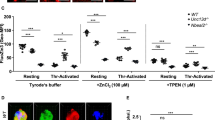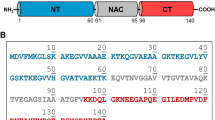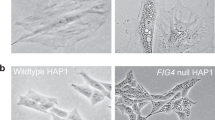Abstract
Pallid (pa) is 1 of 13 platelet storage pool deficiency (SPD) mouse mutants1,2,3. pa animals suffer from prolonged bleeding time, pigment dilution, kidney lysosomal enzyme elevation, serum α1-antitrypsin activity deficiency and abnormal otolith formation2,4,5,6. As with other mouse mutants of this class, characterization of pa mice suggests a defect in organelle biosynthesis. Here we describe the physical mapping, positional cloning, and mutational and functional analysis of the gene that is defective in pa mice. It encodes a ubiquitously expressed, highly charged 172–amino-acid protein (termed pallidin) with no homology to known proteins. We detected a nonsense mutation at codon 69 of this gene in the pallid mutant. In a yeast two-hybrid screen, we discovered that pallidin interacts with syntaxin 13, a t-SNARE protein that mediates vesicle-docking and fusion7,8. We confirmed this interaction by co-immunoprecipitation assay. Immunofluorescence studies corroborate that the cellular distribution of pallidin overlaps that of syntaxin 13. Whereas the mocha and pearl SPD mutants have defects in Ap-3 (Refs 9,10), our findings suggest that pa SPD mutants are defective in a more downstream event of vesicle-trafficking: namely, vesicle-docking and fusion.
This is a preview of subscription content, access via your institution
Access options
Subscribe to this journal
Receive 12 print issues and online access
$209.00 per year
only $17.42 per issue
Buy this article
- Purchase on Springer Link
- Instant access to full article PDF
Prices may be subject to local taxes which are calculated during checkout





Similar content being viewed by others
References
Roberts, E. A new mutation in the house mouse (Mus musculus). Science 74, 569 (1931).
Novak, E.K., Hui, S.-W. & Swank, R.T. Platelet storage pool deficiency in mouse pigment mutations associated with seven distinct genetic loci. Blood 63, 536–544 (1984).
Lyon, M.F. & Searle, A.G. Genetic Variants and Strains of the Laboratory Mouse 274–275, 841 (Oxford University Press, Oxford, 1989).
Martorana, P.A. et al. The pallid mouse. A model of genetic α1-antitrypsin deficiency. Lab. Invest. 68, 233–241 (1993).
Theriault, L.L. & Hurley, L.S. Ultrastructure of developing melanosomes in C57 black and pallid mice. Dev. Biol. 23, 261–275 (1970).
Novak, E.K. & Swank, R.T. Lysosomal dysfunctions associated with mutations at mouse pigment genes. Genetics 92, 189–204 (1979).
Advani, R.J. et al. Seven novel mammalian SNARE proteins localize to distinct membrane compartments. J. Biol. Chem. 273, 10317–10324 (1998).
Prekeris, R., Klumperman, J., Chen, Y.A. & Scheller, R.H. Syntaxin 13 mediates cycling of plasma membrane proteins via tubulovesicilar recycling endosomes. J. Cell Biol. 143, 957–971 (1998).
Kantheti, P. et al. Mutation in AP-3 δ in the mocha mouse links endosomal transport to storage deficiency in platelets, melanosomes, and synaptic vesicles. Neuron 21, 111–122 (1998).
Feng, L. et al. The β3A subunit gene (Ap3b1) of the AP-3 adaptor complex is altered in the mouse hypopigmentation mutant pearl, a model for Hermansky-Pudlak syndrome and night blindness. Hum. Mol. Genet. 8, 323–330 (1999).
White, R.A. et al. The murine pallid mutation is a platelet storage pool disease associated with the protein 4.2 (pallidin) gene. Nature Genet. 2, 80–83 (1992).
Robinson, R.A. et al. Location of the mouse β-2 microglobulin gene B2m determined by linkage analysis. Immunogenetics 14, 449–452 (1981).
White, R.A., Dowler, L.L., Hummel, G.S. & Adkison, L.R. Exclusion of Epb4.2 as a candidate for the mouse mutant pallid. Mouse Newsletter 95, 492–494 (1997).
Gwynn, B., Korsgren, C., Cohen, C.M., Ciciotte, S.L. & Peters, L.L. The gene encoding protein 4.2 is distinct from the mouse platelet storage pool deficiency mutation pallid. Genomics 42, 532–535 (1997).
Zuberi, A.R., Nguyen, H.Q., Auman, H.J., Taylor, B.A. & Roopenian, D.C. A genetic linkage map of mouse chromosome 2 extending from thrombospondin to paired box gene 1, including the H3 minor histocompatibility complex. Genomics 33, 75–84 (1996).
Dietz H.C. et al. The skipping of constitutive exons in vivo induced by nonsense mutations. Science 259, 680–683 (1993).
Dell'Angelica, E.C., Klumperman, J., Stoorvogel, W. & Bonifacino, J.S. Association of the AP-3 adaptor complex with clathrin. Science 280, 431–434 (1998).
Ooi, C.E. et al. Altered expression of a novel adaptin leads to defective pigment granule biogenesis in the Drosophila eye color mutant garnet. EMBO J. 16, 4508–4518 (1997).
Simpson, F., Peden, A.A., Christopoulou, P.L. & Robinson, M.S. Characterization of the adaptor-related protein complex, AP-3. J. Cell Biol. 137, 835–845 (1997).
Dell'Angelica, E.C. et al. AP-3: an adaptor-like protein complex with ubiquitous expression. EMBO J. 16, 917–928 (1997).
Barbosa, M.D.F.S. et al. Identification of the homologous beige and Chediak-Higashi syndrome genes. Nature 382, 262–265 (1996).
Nagle, D.L. et al. Identification and mutation analysis of the complete gene for Chediak-Higashi syndrome. Nature Genet. 14, 307–311 (1996).
Feng, F.H., Bailin, T., Oh, J. & Spritz, R.A. Mouse pale ear (ep) is homologous to human Hermanshy-Pudlak syndrome and contains a rare 'AT-AC' intron. Hum. Mol. Genet. 6, 793–797 (1997).
Gardner, J.M. et al. The mouse pale ear (ep) mutation is the homologue of human Hermansky-Pudlak syndrome. Proc. Natl Acad. Sci. USA 94, 9238–9243 (1997).
Oh, J. et al. Mutation analysis of patients with Hermansky-Pudlak syndrome: a frameshift hot spot in the HPS gene and apparent locus heterogeneity. Am. J. Hum. Genet. 62, 593–598 (1998).
Huang, L. & Gitschier, J. A novel gene involved in zinc transport is deficient in the lethal milk mouse. Nature Genet. 17, 292–297 (1997).
James, P., Halladay, J. & Craig, E.A. Genomic libraries and a host strain designed for highly efficient two-hybrid selection in yeast. Genetics 144, 1425–1436 (1996).
O'Donohue, M.F., Cheutin, T., Klein, C., Kaplan, H. & Ploton, D. Mounting technique allows observation of immuno-labeled cells on plastic coverslips. Biotechniques 24, 910–914 (1998).
Acknowledgements
We thank D. Ma, L. Pawlikowska, M.-C. Cheung, M. Gunthorpe, J. DeYoung and H. Consengco for technical assistance, advice and reagents, and members of our laboratory for discussions. Part of this research was supported by a grant from the NIDDK. J.G. is an investigator with the Howard Hughes Medical Institute.
Author information
Authors and Affiliations
Corresponding author
Rights and permissions
About this article
Cite this article
Huang, L., Kuo, YM. & Gitschier, J. The pallid gene encodes a novel, syntaxin 13-interacting protein involved in platelet storage pool deficiency. Nat Genet 23, 329–332 (1999). https://doi.org/10.1038/15507
Received:
Accepted:
Issue Date:
DOI: https://doi.org/10.1038/15507
This article is cited by
-
SNAREs define targeting specificity of trafficking vesicles by combinatorial interaction with tethering factors
Nature Communications (2019)
-
Cell Biology of the BLOC-1 Complex Subunit Dysbindin, a Schizophrenia Susceptibility Gene
Molecular Neurobiology (2011)
-
The dysbindin-containing complex (BLOC-1) in brain: developmental regulation, interaction with SNARE proteins and role in neurite outgrowth
Molecular Psychiatry (2010)
-
Melanosomes — dark organelles enlighten endosomal membrane transport
Nature Reviews Molecular Cell Biology (2007)
-
Distinctive Profiles of Gene Expression in the Human Nucleus Accumbens Associated with Cocaine and Heroin Abuse
Neuropsychopharmacology (2006)



